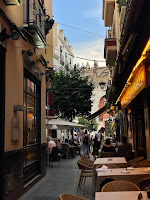Last month, two of my work pals and I went to Seville for a City Break. We chose to go during the week when it is less busy than the weekends, and also late September when it is not quite so hot as the summers tend to be. Seville happens to be the warmest city in continental Europe. It is also the hottest major metropolitan area in Europe, with summer average high temperatures of above 35C (95F) and also the hottest in Spain. The week before we visited it was averaging daytime temperatures of 38/39C! Way too hot for us although it was still in the low 30's and quite humid while we were there. Thankfully the evenings were cooler.
Seville is approximately 2,200 years old. Various civilisations have been instrumental in its growth and has left the city with a distinct personality and a large and well-preserved historical centre including three UNESCO World heritage sites.
It is indeed unique and beautiful. We spent 4 days and 3 nights there which was enough for a city break and an introduction to Seville, but I would love to go back again and explore more of the city as there's so much to see. It's a place I imagine I would never tire of.
We stayed in a charming Airbnb apartment just on the outskirts of the city centre, about a 20 minute walk into town. It's always nice to experience a local feel and to relish the quietness you don't necessarily get when you're in the thick of things.
We had no real itinerary planned but had booked the Restaurant Recovero with a rooftop terrace for our first night so we could see views fo the city at night and get a sense of where we were. The vista was of course stunning and the food was delicious.
We loved walking through the narrow winding streets exploring the shops and myriad cafes and tapas bars to stop for a coffee or refreshing glass of Sangria. An excuse to rest weary legs, not that we needed one!
 We also visited Las Dueñas Palace which we stumbled across on our way to the Metropol Parasol. The Palace has a wonderfully diverse collection of art and sculpture set in stunning architecture that included styles from the Gothic-Mudejar era to the Renaissance period.
We also visited Las Dueñas Palace which we stumbled across on our way to the Metropol Parasol. The Palace has a wonderfully diverse collection of art and sculpture set in stunning architecture that included styles from the Gothic-Mudejar era to the Renaissance period.
We also went to see the Alcazar of Seville and Seville Cathedral and La Giralda but did not go on the tours inside as the queues were too long. The Cathedral is one of the largest in the world behind St Peter's in Rome and St Paul's in London. The Giralda tower was once part of a mosque that was originally there and this is evident in it's architectural style.

 Situated in the Plaza de la Encarnación, the Metropol Parasol also known as the 'mushrooms of Seville' is an ultra modern structure, opened in 2011. It was designed by a German architect, Jürgen Mayer, who won a competition to revitalise the square. It is the largest wooden construction in the world.
Situated in the Plaza de la Encarnación, the Metropol Parasol also known as the 'mushrooms of Seville' is an ultra modern structure, opened in 2011. It was designed by a German architect, Jürgen Mayer, who won a competition to revitalise the square. It is the largest wooden construction in the world.
There is also an antiquarian museum in the basement, along with market stalls and bars on the ground floor, where we sampled some local sherry and bought vacuum packed Manchego cheese and cured meat to bring home with us.
After another full day of walking till our feet ached, our last night was spent at a lovely restaurant near the cathedral. Fitting in quite nicely with the locals who like to eat late, we had tapas and sangria, serenaded by street musicians.
Seville has definitely left a stamp on my heart (and my passport) and I hope to return again very soon.
* * * * *



